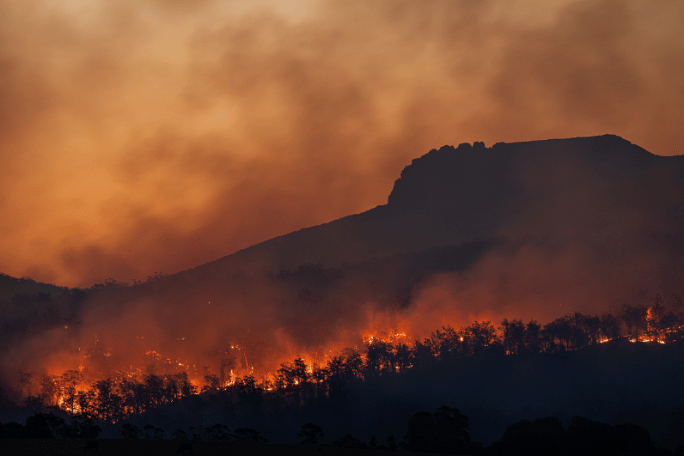Lesson summary
Native Australian flora and fauna have evolved to live with bushfires. As fires become more frequent, these natural adaptations may no longer provide enough protection. Part of scientists’ real-world work is to intervene to help threatened species survive the fires.
Students will be challenged to build upon natural fire-resistant adaptations to develop solutions that help plants and animals survive and thrive in difficult conditions.
Learning intentions:
Students will...
- understand the impact of bushfires on the Australian landscape, flora, and fauna
- understand the work scientists are undertaking to protect and preserve the Australian landscape, flora, and fauna in the wake of bushfires
- understand the ways flora and fauna have adapted to survive the Australian climate, and specifically the threat of bushfires.
Success criteria:
Students can...
- conduct independent research
- identify ways in which native flora have adapted lifecycle structures to benefit from regular bushfires
- identify challenges faced by native flora in repopulating bushfire affected areas
- identify ways in which native fauna have adapted to respond to and protect themselves from the threat of bushfires
- identify threats and challenges to survival faced by native fauna in the aftermath of a bushfire
- think critically and creatively to apply human interventions to further assist flora and fauna in surviving bushfires and successfully repopulating in the aftermath of a bushfire.
Lesson guides and printables
Lesson details
Curriculum mapping
Australian Curriculum content descriptions:
Years 5 Design and Technology:
- Examine how people in design and technologies occupations address competing considerations, including sustainability in the design of products, services, and environments for current and future use (ACTDEK019)
- Investigate characteristics and properties of a range of materials, systems, components, tools and equipment and evaluate the impact of their use (ACTDEK023)
- Critique needs or opportunities for designing, and investigate materials, components, tools, equipment and processes to achieve intended designed solutions (ACTDEP024)
- Generate, develop and communicate design ideas and processes for audiences using appropriate technical terms and graphical representation techniques (ACTDEP025)
Years 5 Science:
- Living things have structural features and adaptations that help them to survive in their environment (ACSSU043)
- Scientific knowledge is used to solve problems and inform personal and community decisions (ACSHE083)
Syllabus outcomes: ST3-10LW, ST3-7PW, ST3-14BE, ST3-13MW, ST3-5WT
General capabilities: Critical and Creative Thinking
Cross-curriculum priority: Sustainability
Relevant parts of Year 5 Design and Technology achievement standards: Students describe competing considerations in the design of products, services and environments, taking into account sustainability. They describe how design and technologies contribute to meeting present and future needs.
Relevant parts of Year 5 Science achievement standards: Students analyse how the form of living things enables them to function in their environments. Students discuss how scientific developments have affected people’s lives, help us solve problems and how science knowledge develops from many people’s contributions.
This lesson is part of the wider unit of work: Beyond the Bushfires – Primary
Time required: 55 min
Level of teacher scaffolding: Low – facilitate class discussion, support students’ independent research and design
Resources required
- Article – The Conversation – Scientists find burnt, starving koalas weeks after the bushfires
- Article – The Conversation – Many of our plants and animals have adapted to fires, but now the fires are changing
- Devices capable of independent research, such as an iPad or laptop – one per student
- Device capable of presenting a video to the class
- Student Worksheets – one copy per student
Skills
This lesson is designed to build students’ competencies in the following skills:
- Communication
- Community engagement
- Creativity
- Critical thinking
- Enterprise
- Problem solving
Additional info
In partnership with The Conversation, the Beyond the Bushfires series brings the words of scientists who are actively involved in research and science communication into classrooms throughout Australia. Students will explore evidence-based research embedded in the context of real-world practice.
Additional thanks to the Ian Potter Foundation, John T Reid Charitable Trusts and The Myer Foundation, for generously supporting the development of these lessons


Welcome back!
Don't have an account yet?
Log in with:
By signing up to Cool.org you consent and agree to Cool's privacy policy to
store, manage and process your personal information. To read more, please see
our privacy policy here(Opens in new tab).
Create your free Cool.org account.
Many of our resources are free, with an option to upgrade to Cool+ for premium content.
Already have an account?
Sign up with:
By signing up to Cool.org you consent and agree to Cool's privacy policy to
store, manage and process your personal information. To read more, please see
our privacy policy here(Opens in new tab).